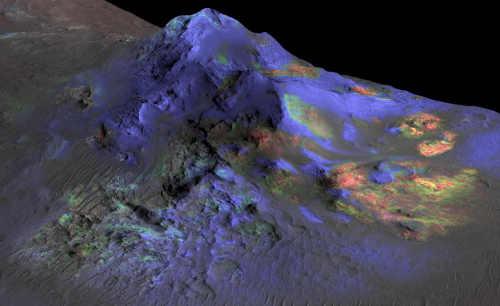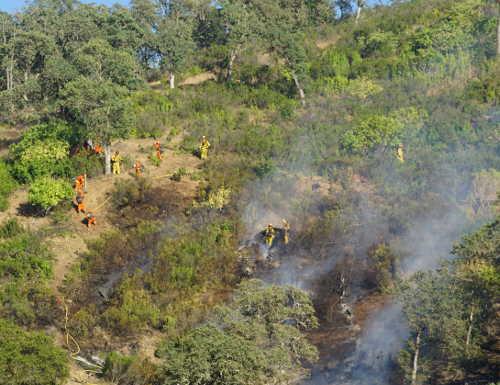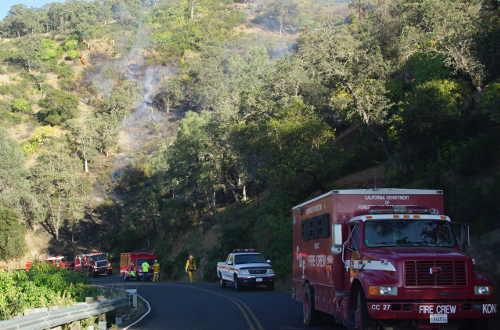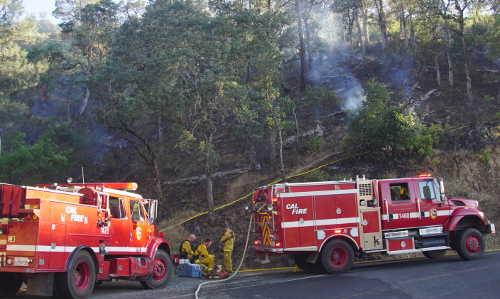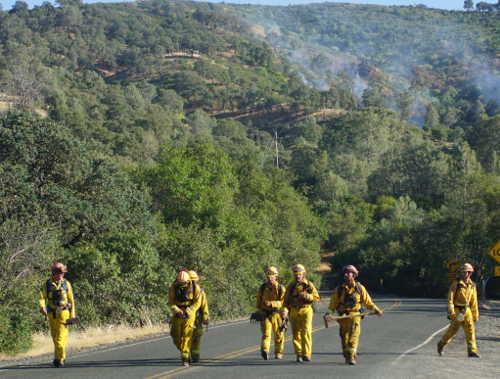MIDDLETOWN, Calif. – Pacific Gas and Electric offered community members an update this week about a cleanup project at a former geothermal waste collection site near Middletown.
The Middletown Area Town Hall, or MATH, hosted the presentation at its meeting Thursday evening at the Middletown Senior Center.
The presentation and a question-and-answer session takes place from the 17:14 minute mark to the 55:40 minute mark in the video above.
Geothermal Inc. operated the facility from 1976 to 1986 on 40 acres of a 460-acre property on Butts Canyon Road.
Rob Saur, PG&E's project manager for the site, explained that the dump facility consisted of evaporation ponds and solid waste disposal trenches which received waste from the exploration, development and operations at The Geysers energy field and power plant.
He said the waste materials – consisting primarily of drilling muds, drill cuttings, sump and plant process water – have been tested and are not hazardous.
After Geothermal Inc. went bankrupt, the 17 companies and agencies that had sent waste there – including PG&E – became responsible for the landfill closure, Saur said. PG&E took over the responsibility of the facility's closure and maintenance after purchasing the property in 2003.
Saur said the site closure took place between 2003 and 2006 under a plan approved by the Central Valley Regional Water Quality Control Board.
The closure entailed consolidating the waste materials into a single, closed, six-acre landfill that has a cap over it. As part of that process, he said they had to solar evaporate 21 million gallons out of the ponds in order to remove the muds and waste material, which was moved to the closed landfill.
Once the wastes were in the landfill, Saur said the wastes were capped with a high-density plastic layer, covered with a coarse drainage layer, over which was placed a clean soil cover and native grasses. He said the cap is meant to eliminate future infiltration of stormwater and rainwater through the waste material that's in the landfill.
As part of the closure, PG&E was required to create a separation between the bottom of the landfill and the groundwater, Saur said.
To do that, they lowered the spillway of nearby Freeman Lake and planted 32 acres of eucalyptus trees around the landfill. He said the trees' deep root systems tap into the water and act as pumps, pulling up the water and lowering the water level around the landfill. He said PG&E also created four acres of new wetlands and restored additional habitat.
Since the closure was completed, PG&E has been performing ongoing maintenance activities at the site which include inspection and maintenance of the closed landfill and tree plantings, mowing grass on the property and utilizing goats to create a fire break around the landfill, and trimming the trees, Saur said.
The work also includes groundwater and surface water monitoring. “Groundwater samples have been collected from this site for over 20 years, and we continue to do that today, and we'll be doing it far into the future as well,” Saur said.
PG&E collects samples from groundwater and surface water, and sends those samples to a laboratory for analysis, with the results reported to the State Water Board on a semiannual basis, he said.
Saur said the results of the testing before the closure and currently has shown that there are elevated concentrations of total dissolved solids – chloride, boron and sulfate – in the groundwater in the landfill's immediate vicinity.
Between 2011 and 2014, PG&E performed extensive studies to evaluate the effectiveness of the implemented closure. Saur said that work included drilling, installing equipment to measure water levels, field studies, testing of different alternatives and used a tool to help them predict future groundwater conditions.
Regarding the current closure status, Saur said the closure requirements have been met – except they have not been able to achieve the required year-round 5-foot separation between the groundwater and the waste. He said the groundwater impacts are stable and limited to the landfill's immediate vicinity.
Saur said PG&E is committed to achieving the separation requirement. Late last year, they began studies which led in April to the submission of a feasibility study and corrective action plan to the State Water Board for review.
PG&E looked at more than a dozen technologies and options to achieve the separation requirement, including underground barrier walls, groundwater extraction trenches, planting more trees around the landfill and removing some of the waste from the areas where they can't get the separation, Saur said.
Saur said PG&E proposed to the State Water Board to make drainage improvements to move stormwater from the landfill, which has been infiltrated by stormwater, and to build an underground barrier wall made of concrete slurry 20 feet into the ground to divert groundwater away from the landfill.
He said PG&E anticipates the State Water Board will approve the plan this year. Once that's done, they plan perform field work – possibly as early as this summer – to collect data to finalize design and engineering for the drainage work and the wall.
The drainage improvements are expected to take place in late summer or early fall, with the underground barrier likely to take place in the summer or fall of next year, Saur said.
Saur said that after the work is completed, PG&E will continue to monitor the site to ensure that the measure are successful.
Prior to the field work, PG&E will distribute work notices, place phone calls and emails to neighbors, and will provide updates to MATH as requested, Saur said. PG&E also is available by phone at all times for concerned community members.
PG&E received certification from the Wildlife Habitat Council for habitat created during the closure activities, Saur said.
Middletown High School students have been coming out to the site for the last few years to help monitor the wildlife habitat and to learn about closure and restoration activities. Saur said the company is looking forward to continuing working with the school in the next school year.
Following his presentation, Saur, along with Tracy Craig of PG&E Community Relations and Brian Bottari of the company's governmental affairs department, answered questions about life expectancy of the project, the materials used for capping, monitoring well locations and testing samples.
Asked about the plastic cap, which is underground, Saur said it's permanent, and is expected to last at least 50 years. It's inspected and will be replaced if there are problems.
MATH Board member Charlotte Kubiak asked why the waste materials had to be kept away from the groundwater if the materials aren't hazardous.
Saur said the materials were neither toxic nor hazardous, but the property was a disposal site that took waste – at the level between where household garbage would have been taken and a hazardous waste dump site – and so PG&E had to follow the state's closure requirements.
Kubiak asked about how to find out how the site was impacting groundwater and therefore the drinking water.
“We do not think that it's affecting the drinking water here,” said Saur, noting that PG&E has been monitoring the site for more than 20 years. They know where the groundwater impacts associated with the landfill are – they're in the landfill vicinity – and they have a robust monitoring network that will continue to help them monitor impacts.
Linda Diehl-Darms said it was important to let people know that the original dump site's linings were not good – which Saur acknowledged – and they leaked materials into the groundwater.
“Is there still a plume that goes towards Middletown in the groundwater?” she asked.
Saur said they think a lot of the groundwater impacts were the result of when the unlined ponds were in operation, before the facility was closed. He said the muds went into the ponds and water that came into contact with the wastes leached into the groundwater.
“These impacts have been there for many years and, yes, there is a groundwater plume there, still, but it is stable and in an isolated area,” Saur said.
Monica Rosenthal asked about the location of the site's monitoring wells. Saur said there are dozens of wells, the majority of them on the waste site, with some off site.
To test them, PG&E checks the water levels, pumps up the water, takes samples and sends those off for laboratory analysis, Saur said. The wells – in all directions around the landfill – are monitored on a quarterly or semiannual basis.
Dave Rosenthal asked the distance of the wells from the dump site. Saur said the furthest one away is located a quarter of a mile from the site.
Tom Darms raised questions about whether or not the groundwater would go around the underground barrier, and why a lining wasn't put into the bottom of the landfill.
Saur said they've looked at conditions in wet and dry years by using a groundwater model. He said they believe the underground barrier will work even in wet years.
As for a lining, he said the drilling muds in the landfill are basically the same materials as would have been used to line the landfill, so they didn't feel there was value in removing all the waste and then putting it back.
“It's important to note that we're not going at this alone. There is a very stringent regulatory agency over our shoulder on all of this. You don't have to take our word for it,” said Bottari.
The final question came from Kubiak, who asked the PG&E representatives if they would drink water from the tap if they lived in Middletown.
They said yes.
Community members who have questions or concerns can contact PG&E's environmental remediation hotline, 866-247-0581 or This email address is being protected from spambots. You need JavaScript enabled to view it. ; Saur at 925-415-6371, This email address is being protected from spambots. You need JavaScript enabled to view it. ; or Craig, PG&E Community Relations, 510-334-4866, This email address is being protected from spambots. You need JavaScript enabled to view it. .
Email Elizabeth Larson at This email address is being protected from spambots. You need JavaScript enabled to view it. . Follow her on Twitter, @ERLarson, or Lake County News, @LakeCoNews.












